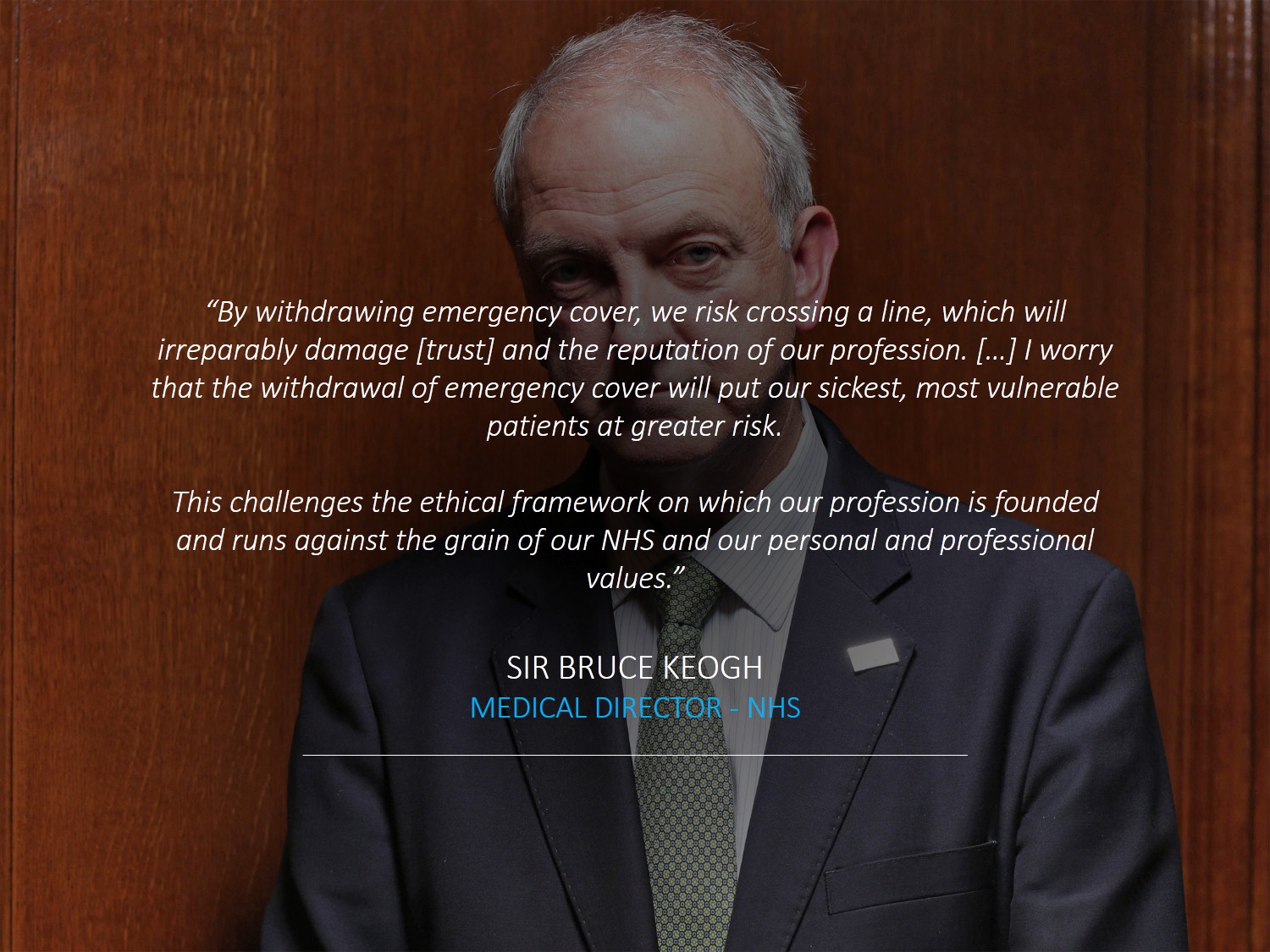Support for Junior Doctor Strikes
Trends in public support for Junior Doctors
THE MORNING AFTER THE NIGHT BEFORE
Last week, Junior Doctors in England conducted the first all-out strike in the almost 70 year history of the NHS. In the lead-up to the strike (which included the controversial withdrawal of emergency cover) there were fears over an increase in patient deaths, appeals from Sir Bruce Keogh to Junior Doctors not to strike, fierce exchanges between the BMA and Department of Health, and a final-hour cross-party proposal to help avoid the strike altogether. Unsurprisingly for a dispute that has been on-going for over two years, all of these pleas and appeals fell on deaf ears. And so, at 8am on Tuesday 26 April the public, the media, the BMA and the Government held their breaths to see what the fall-out from the largest strike in NHS history would be.So a week on, what does the fall-out look like?PUBLIC SUPPORT OVER TIMEOur healthcare team has conducted four separate waves of research into public support for the Junior Doctor strikes ? ever since the BMA first announced their intention to strike back in October 2015. Looking at these results cumulatively paints a rather good picture of how public support for the strikes has evolved over the course of the past few months.
Unsurprisingly for a dispute that has been on-going for over two years, all of these pleas and appeals fell on deaf ears. And so, at 8am on Tuesday 26 April the public, the media, the BMA and the Government held their breaths to see what the fall-out from the largest strike in NHS history would be.So a week on, what does the fall-out look like?PUBLIC SUPPORT OVER TIMEOur healthcare team has conducted four separate waves of research into public support for the Junior Doctor strikes ? ever since the BMA first announced their intention to strike back in October 2015. Looking at these results cumulatively paints a rather good picture of how public support for the strikes has evolved over the course of the past few months. Overall, when we look at public support across the entire UK population we can see that the balance of favour has always come down on the side of the Junior Doctors. In fact, given the partisan and ideological nature of the dispute between the Junior Doctors and the Government it is quite surprising that even at its peak, opposition only reached 39% of UK adults.But what these results really demonstrate is that contrary to all of the warnings around patient safety and arguments around the unethical nature of the strikes, public support has largely increased as the strikes have happened ? rather than shrunk away. Our first two waves in October and November were conducted following the BMA?s announcement of the strike dates. As you can see, public opinion in November with the announcement of the December strike dates was quite polarised with a miniscule 2% gap between support and opposition. But our last two waves in January and April were conducted during the actual strikes themselves and show that public opinion has tended to sway massively towards the doctors with the withdrawal of services, rather than away from them.And while we did see a small decrease in support (-4%) and accompanying small increase in opposition (+7%) during the latest strikes, the overwhelming balance of favour was still in support. We would need to conduct a follow-up wave next month to see if these decreases reflect a turn against the strikes in general or whether these decreases were a reaction against the unprecedented removal of emergency cover.But for now at least, the number of supporters remains almost double the number of oppositionists.THE ANATOMY OF SUPPORTThe simplicity of these support figures, however, hide the fact that the distribution of support has been rather fluid with different segments of the population waxing and waning over time. From the rather complex chart below, which shows the levels of support and opposition for different demographic groups over time, we can discern a few common themes.
Overall, when we look at public support across the entire UK population we can see that the balance of favour has always come down on the side of the Junior Doctors. In fact, given the partisan and ideological nature of the dispute between the Junior Doctors and the Government it is quite surprising that even at its peak, opposition only reached 39% of UK adults.But what these results really demonstrate is that contrary to all of the warnings around patient safety and arguments around the unethical nature of the strikes, public support has largely increased as the strikes have happened ? rather than shrunk away. Our first two waves in October and November were conducted following the BMA?s announcement of the strike dates. As you can see, public opinion in November with the announcement of the December strike dates was quite polarised with a miniscule 2% gap between support and opposition. But our last two waves in January and April were conducted during the actual strikes themselves and show that public opinion has tended to sway massively towards the doctors with the withdrawal of services, rather than away from them.And while we did see a small decrease in support (-4%) and accompanying small increase in opposition (+7%) during the latest strikes, the overwhelming balance of favour was still in support. We would need to conduct a follow-up wave next month to see if these decreases reflect a turn against the strikes in general or whether these decreases were a reaction against the unprecedented removal of emergency cover.But for now at least, the number of supporters remains almost double the number of oppositionists.THE ANATOMY OF SUPPORTThe simplicity of these support figures, however, hide the fact that the distribution of support has been rather fluid with different segments of the population waxing and waning over time. From the rather complex chart below, which shows the levels of support and opposition for different demographic groups over time, we can discern a few common themes. First of all, men have opposed the strikes in significantly higher numbers than women every single time we have asked our questions. In contrast, women have been one of the staunchest supporters of the strikes and have seen their level of support increase significantly since the beginning of the year ? perhaps due to the news of legal action against the new contract on the basis it discriminates against female doctors. Finally, the strongest opposition to the strikes comes from those aged 55 and over, with the youngest generation (those aged 18-34) showing the most erratic set of results that swing from overwhelming support to a more uncertain level of support.This fluidity of support becomes even more interesting when we analyse the results by which party respondents voted for at the 2015 election. The chart below shows that support for the strikes dwindles most at the far-right edges of the political spectrum, with UKIP and Conservative voters the most likely to oppose them. In contrast, Labour and Liberal Democrat voters are most likely to support the Junior Doctor strikes ? with support from Labour voters increasing significantly over the past few months.
First of all, men have opposed the strikes in significantly higher numbers than women every single time we have asked our questions. In contrast, women have been one of the staunchest supporters of the strikes and have seen their level of support increase significantly since the beginning of the year ? perhaps due to the news of legal action against the new contract on the basis it discriminates against female doctors. Finally, the strongest opposition to the strikes comes from those aged 55 and over, with the youngest generation (those aged 18-34) showing the most erratic set of results that swing from overwhelming support to a more uncertain level of support.This fluidity of support becomes even more interesting when we analyse the results by which party respondents voted for at the 2015 election. The chart below shows that support for the strikes dwindles most at the far-right edges of the political spectrum, with UKIP and Conservative voters the most likely to oppose them. In contrast, Labour and Liberal Democrat voters are most likely to support the Junior Doctor strikes ? with support from Labour voters increasing significantly over the past few months. Before concluding that political ideology is at the heart of whether people support or oppose these strikes, however, we should keep in mind that the implementation of the seven-day NHS (which this contract is designed to support) was a Conservative manifesto pledge, which would explain the high levels of opposition from Conservative voters. Or it may be that having voted in the first majority Conservative government since 1992, Conservative voters are reluctant to turn against their own camp. As the results below demonstrate, Conservative voters are the only group to hold the BMA more responsible for the current dispute than Jeremy Hunt.
Before concluding that political ideology is at the heart of whether people support or oppose these strikes, however, we should keep in mind that the implementation of the seven-day NHS (which this contract is designed to support) was a Conservative manifesto pledge, which would explain the high levels of opposition from Conservative voters. Or it may be that having voted in the first majority Conservative government since 1992, Conservative voters are reluctant to turn against their own camp. As the results below demonstrate, Conservative voters are the only group to hold the BMA more responsible for the current dispute than Jeremy Hunt. In all other quarters (including among UKIP voters), the Government is held most responsible for the current fracas with the Junior Doctors. And so while it remains to be seen if this contract will indeed be Jeremy Hunt?s ?last big job in politics?, it certainly seems that attempts to lay blame at the feet of the BMA has largely fallen flat among the UK public.WHAT HAPPENS NOW?
In all other quarters (including among UKIP voters), the Government is held most responsible for the current fracas with the Junior Doctors. And so while it remains to be seen if this contract will indeed be Jeremy Hunt?s ?last big job in politics?, it certainly seems that attempts to lay blame at the feet of the BMA has largely fallen flat among the UK public.WHAT HAPPENS NOW? Going into last week?s strike, there was fear on all sides around the possibility of patient deaths being attributed to the withdrawal of emergency services. Any such event might just turn the tide against the BMA and Junior Doctors, vindicating claims that the strike was ?irresponsible? and potentially unethical. There was a palpable tension on Tuesday morning, as the NHS entered unchartered territory and the public waited to see what would happen.But such stories of patient deaths never materialised. One story did emerge at the beginning of this week of woman who lost her daughter, but her criticism was pointedly aimed at Jeremy Hunt ? rather than the doctors. Statistics on admissions during the strike are yet to be released, but we spoke to a number of senior doctors about their experiences during the strike.
Going into last week?s strike, there was fear on all sides around the possibility of patient deaths being attributed to the withdrawal of emergency services. Any such event might just turn the tide against the BMA and Junior Doctors, vindicating claims that the strike was ?irresponsible? and potentially unethical. There was a palpable tension on Tuesday morning, as the NHS entered unchartered territory and the public waited to see what would happen.But such stories of patient deaths never materialised. One story did emerge at the beginning of this week of woman who lost her daughter, but her criticism was pointedly aimed at Jeremy Hunt ? rather than the doctors. Statistics on admissions during the strike are yet to be released, but we spoke to a number of senior doctors about their experiences during the strike. Their comments tell a story of a NHS that united to support Junior Doctors and ensure that safe and effective care was still delivered. In some A&E departments, we heard how patient numbers had reduced significantly as the public with non-urgent illnesses stayed away from hospital and sought help from GPs and walk-in clinics instead.We could point to this reduction in patient numbers as evidence that the withdrawal of emergency cover induced fear in some patients who needed help. Certainly, 51% of UK adults agree that withdrawing emergency cover is a step too far when it comes to combating the contract imposition. But looking at the results below, I?m more tempted to interpret this reduction as a symbol of solidarity between the public and the doctors.
Their comments tell a story of a NHS that united to support Junior Doctors and ensure that safe and effective care was still delivered. In some A&E departments, we heard how patient numbers had reduced significantly as the public with non-urgent illnesses stayed away from hospital and sought help from GPs and walk-in clinics instead.We could point to this reduction in patient numbers as evidence that the withdrawal of emergency cover induced fear in some patients who needed help. Certainly, 51% of UK adults agree that withdrawing emergency cover is a step too far when it comes to combating the contract imposition. But looking at the results below, I?m more tempted to interpret this reduction as a symbol of solidarity between the public and the doctors. Well over 50% of UK adults trust the Junior Doctors more than the government, almost half believe that this contract is an attempt to break up with the NHS and less than a third think that this dispute is about pay and nothing else. It would appear that the BMA and Junior Doctors have put forward their arguments to the public and had them accepted, in large part.
Well over 50% of UK adults trust the Junior Doctors more than the government, almost half believe that this contract is an attempt to break up with the NHS and less than a third think that this dispute is about pay and nothing else. It would appear that the BMA and Junior Doctors have put forward their arguments to the public and had them accepted, in large part. So effectively, in fact, that the majority would support further strike action in the future.
So effectively, in fact, that the majority would support further strike action in the future. The new Junior Doctor contract is due to start being implemented from the end of this month. Today, 22 medical colleges and faculties have put forward a proposal aimed at breaking the deadlock and resuming talks between the two sides. Our results over the past few months, plus our latest polling, suggest that the Government has more to gain (in terms of minimising reputational damage) from resuming talks than the BMA.
The new Junior Doctor contract is due to start being implemented from the end of this month. Today, 22 medical colleges and faculties have put forward a proposal aimed at breaking the deadlock and resuming talks between the two sides. Our results over the past few months, plus our latest polling, suggest that the Government has more to gain (in terms of minimising reputational damage) from resuming talks than the BMA. If discussions are not resumed, the trends in our data suggest that it is the Government that will end up on the losing side of public opinion. But it is not only public opinion that the Department of Health and the Government should be focused on, it is also the danger that this dispute may alienate an entire generation of Junior Doctors and prospective medical students who want to work in a National Health Service but increasingly feel isolated, demoralised, and under-resourced by those in power.
If discussions are not resumed, the trends in our data suggest that it is the Government that will end up on the losing side of public opinion. But it is not only public opinion that the Department of Health and the Government should be focused on, it is also the danger that this dispute may alienate an entire generation of Junior Doctors and prospective medical students who want to work in a National Health Service but increasingly feel isolated, demoralised, and under-resourced by those in power. Moving forward, the Opinium Healthcare team will continue to monitor public attitudes towards this situation as it unfolds in the coming months. But for now, at least, the fall-out from the latest strikes appears to have drifted almost entirely towards Whitehall, where doctors have been waiting to speak to Jeremy Hunt.James leads the Healthcare practice at Opinium Research. If you?d like to know more about our Healthcare practice or our research in this area, feel free to get in touch.
Moving forward, the Opinium Healthcare team will continue to monitor public attitudes towards this situation as it unfolds in the coming months. But for now, at least, the fall-out from the latest strikes appears to have drifted almost entirely towards Whitehall, where doctors have been waiting to speak to Jeremy Hunt.James leads the Healthcare practice at Opinium Research. If you?d like to know more about our Healthcare practice or our research in this area, feel free to get in touch.




